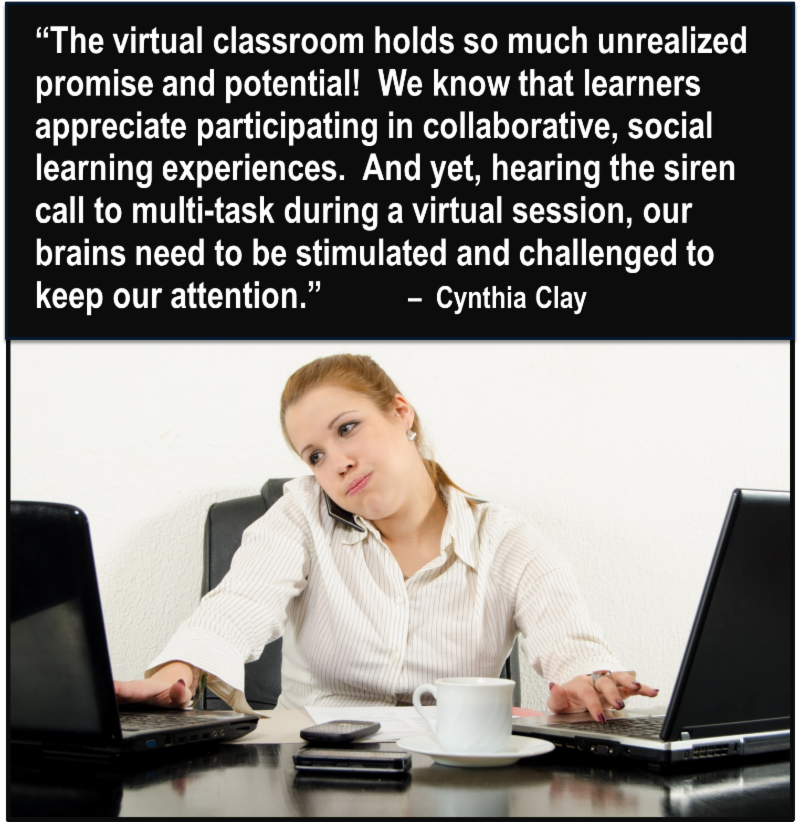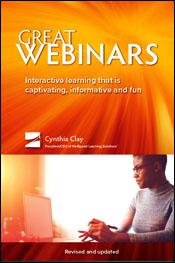|
That's Using Your Noggin: Brain-based Principles for Better Virtual Meetings
|
 I'm sure you've attended many virtual meetings that drove meeting participants to disengage and multitask, keeping one ear tuned to the proceedings, in case someone calls on them by name. One recent study indicated that 80% of participants reported multitasking during video conference calls if there was no reason to participate actively. That's a whole lot of wasted meeting time. I'm sure you've attended many virtual meetings that drove meeting participants to disengage and multitask, keeping one ear tuned to the proceedings, in case someone calls on them by name. One recent study indicated that 80% of participants reported multitasking during video conference calls if there was no reason to participate actively. That's a whole lot of wasted meeting time.
There are some straightforward techniques that help meeting leaders gain and keep people's attention. The COGS model describes four areas of focus that can make the difference between lively virtual meetings and deadly digital disasters.
Clarify Objectives and Outcomes
No meeting (face-to-face or virtual) should take place without some forethought given to the agenda, including what exactly you intend to accomplish and what outcomes you hope to achieve. Yet, all too often, meeting leaders attempt to run virtual meetings "on the fly," guaranteeing limited use of interaction tools and limited engagement. Take 10 minutes to pull together an agenda that clearly spells out what kind of thinking you want your participants to engage in, and how you will expect them to participate online, to achieve clearly defined meeting objectives.
Optimize Creativity and Novelty
Our brains are wired to focus on what's most important or essential for our survival. Simply put, we get bored with the same repetitive discussions and activities. And once we get bored, we tune out and find something else more interesting to focus on. Think about the virtual meetings you attended or led over the past month. Were there any surprises? Were any of the activities creatively designed? There's a plethora of inspiring videos and memes on the Internet. How might you incorporate short videos and colorful graphics in your virtual meeting plan?
Galvanize Attention and Interaction
Galvanize is such a great word. It means "to excite someone into taking action." In a virtual meeting, you galvanize attention and interaction by appealing to emotions and intentionally creating excitement. One simple technique is to consider how you are phrasing discussion questions. Which would be more fun to discuss: "What is the best meeting venue for the training event?" or "What meeting venue would electrify and energize our next training event?" or "If we wanted participants to post tons of photos on Instagram, which venue would we choose?" Certainly, the end result of the discussion will be the best meeting venue but how are you capturing their interest on the way to making that decision?
Solve Interesting Problems
Have you noticed that human beings are problem solvers? Our brains are wired to notice what isn't working and try to fix it. You can capitalize on that cognitive awareness by moving beyond presenting boring information updates to posing interesting case problems, asking thought-provoking questions in virtual meetings, and increasing generative thinking (brainstorming). There's no reason to force a group of people to attend a virtual meeting simply to hear a project update or a mind-numbing presentation filled with information that may seem irrelevant to their daily business challenges. Link whatever content is being presented to a clear business challenge and then engage participants by asking them to figure something out.
COGS captures four critical components of effective virtual meetings. If you'd like to learn more about delivering fantastic virtual meetings, join us for our next complimentary webinar, Great Web Meetings: We've Got to Keep Meeting Like This! on Wednesday, June 26th, 1:00 pm ET / 10:00 am PT.

Cynthia Clay
President/CEO
|
 Trainer Tips: Trainer Tips:
Don't Skip Action Planning
|
We launched a new training program this month for a global pharmaceutical client. Our Virtual Leader program is in high demand as more and more workplaces rely on dispersed team members.
Sherry, our skilled Master Trainer, led a high-energy web workshop filled with meaningful discussions using chat and the phone bridge. These participants were engaged and interactive! It was a great session, so great that we realized that we had too much content to cover before the end of the session. As I observed Sherry in action, I wondered what exactly she was going to skip in order to finish on time. I crossed my fingers and hoped.
If you're a trainer in both the face-to-face and virtual classrooms, you've been faced with this same dilemma: How do you end on time and ensure that participants receive what's most valuable? The temptation is often to skip action planning and hurry through the planned content before wrapping up.
Experienced trainers know, however, that action planning is critical to successful on-the-job application. It works because participants make commitments to do something with the information, often visualizing themselves changing behaviors or practices. It's the first step in adopting new skills. In a virtual training session, reading the commitment statements, typed in chat by colleagues, also reinforces the expectation that behaviors and practices are going to change. They are collectively and publicly stating their planned actions. This is a powerful way to bring an online session to a close and the springboard for continuous improvement.
I watched Sherry skip several slides and discussion questions and jump to action planning before wrapping up. Her participants had no idea she skipped anything because she didn't comment on it. She created an elegant ending with commitments to action. Be like Sherry!
|
| One Final Thought |

|
|
|
Download
Cynthia Clay's
ATD Presentation!
|
Cynthia Clay recently delivered
That's Using Your Noggin: Brain-based Principles for Better Virtual Training at the ATD International Conference and Exhibition in Washington, D.C. If you are interested in reviewing the slides from this engaging, interactive session, you may
download them here.
|
|
The New
Great Webinars
is Launched!
|
 The revised and updated
Great Webinars
is now available for purchase at Amazon. It's hard to imagine that it has been nine years since I first wrote this book. In the latest version, I've updated some of the key points to better reflect improvements in web conference technology. We've also replaced all of the graphic images with more current examples. And, most exciting to me, I've written a new chapter on the cognitive principles that make for great virtual training. The revised and updated
Great Webinars
is now available for purchase at Amazon. It's hard to imagine that it has been nine years since I first wrote this book. In the latest version, I've updated some of the key points to better reflect improvements in web conference technology. We've also replaced all of the graphic images with more current examples. And, most exciting to me, I've written a new chapter on the cognitive principles that make for great virtual training.
If you want to support the virtual trainers in your organization, consider buying multiple copies of Great Webinars. For single copies, buy it directly from Amazon. For 20 or more copies, contact us directly for a volume discount.
|
Explore something new with one of our engaging and interactive webinars or public courses.
Become a Virtual Training Expert with Our Deep-Dive Virtual Facilitator Course!
The July Virtual Facilitator Trainer Certification Course (VFTC) is open for enrollment. T
his wildly popular course always receives rave reviews from participants as it provides a deep-dive into best practices for virtual facilitation and design!
You've seen Cynthia Clay in action month after month, now it's your turn to rock the virtual classroom! The July course opens July 11th, and the first webinar is July 18th.
_______________________
Great Web Meetings: We've Got to Keep Meeting Like This!
Increase the productivity and effectiveness of your online meetings.
_______________________
Strategies to Reduce Conflict in the Virtual Workplace
This session explores how to resolve conflict in in the virtual workplace. This webinar introduces the practical, proven methods contained in
Peer Power: Transforming Workplace Relationships, by Cynthia Clay and Ray Olitt.
Wednesday, July 17th
1:00pm ET / 10:00am PT
Complimentary
|
|
Cynthia Clay's Upcoming Speaking Events
|
 If you are planning to attend an upcoming conference, Cynthia Clay would love to meet you there. If you are planning to attend an upcoming conference, Cynthia Clay would love to meet you there.
June 17 - 19, 2019
Raleigh, NC
Awards Luncheon:
Top Ten Articles
(Training Industry Magazine)
September 17 - 19, 2019
New Orleans, LA
That's Using Your Noggin: Brain-based Principles for Better Virtual Training
Hilton New Orleans Riverside
Wednesday, September 18, 2019, 10:30 - 11:30 a.m.
|
|